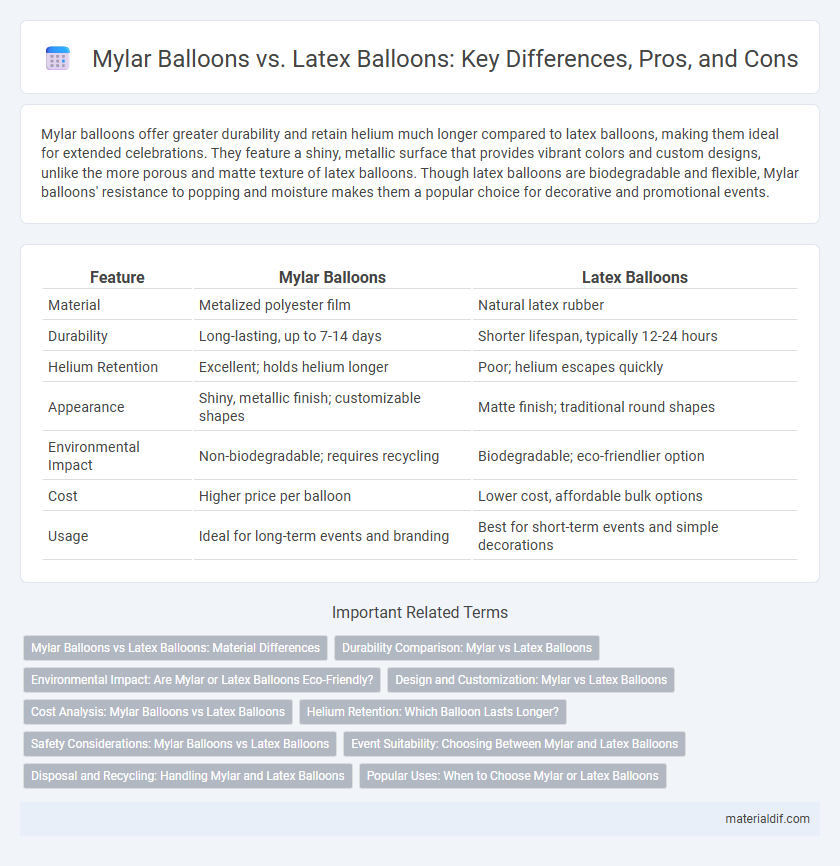Mylar balloons offer greater durability and retain helium much longer compared to latex balloons, making them ideal for extended celebrations. They feature a shiny, metallic surface that provides vibrant colors and custom designs, unlike the more porous and matte texture of latex balloons. Though latex balloons are biodegradable and flexible, Mylar balloons' resistance to popping and moisture makes them a popular choice for decorative and promotional events.
Table of Comparison
| Feature | Mylar Balloons | Latex Balloons |
|---|---|---|
| Material | Metalized polyester film | Natural latex rubber |
| Durability | Long-lasting, up to 7-14 days | Shorter lifespan, typically 12-24 hours |
| Helium Retention | Excellent; holds helium longer | Poor; helium escapes quickly |
| Appearance | Shiny, metallic finish; customizable shapes | Matte finish; traditional round shapes |
| Environmental Impact | Non-biodegradable; requires recycling | Biodegradable; eco-friendlier option |
| Cost | Higher price per balloon | Lower cost, affordable bulk options |
| Usage | Ideal for long-term events and branding | Best for short-term events and simple decorations |
Mylar Balloons vs Latex Balloons: Material Differences
Mylar balloons are made from a synthetic polyester film coated with a thin layer of metal, offering superior durability and a shiny, reflective surface compared to latex balloons, which are crafted from natural rubber derived from rubber trees. The non-porous nature of Mylar helps retain helium gas longer, extending float time significantly beyond the typical 12-24 hours seen with latex balloons prone to quicker helium leakage. Mylar balloons also resist moisture and UV light better than latex, making them ideal for long-term decorative use in various environments.
Durability Comparison: Mylar vs Latex Balloons
Mylar balloons exhibit superior durability compared to latex balloons due to their metallic polyester film construction, which resists punctures and retains helium for several days longer. Latex balloons, made from natural rubber, tend to degrade faster when exposed to environmental factors such as sunlight and moisture, causing them to deflate within hours or a few days. The extended float time and resistance to environmental stress make Mylar balloons the preferred choice for long-lasting decorations.
Environmental Impact: Are Mylar or Latex Balloons Eco-Friendly?
Mylar balloons are made from metallized plastic film, which does not biodegrade and can persist in the environment for years, contributing to pollution and wildlife hazards. Latex balloons, derived from natural rubber, biodegrade more quickly but still pose risks to animals and ecosystems if released outdoors. Both types present environmental challenges, with latex being more eco-friendly due to its natural composition and faster decomposition.
Design and Customization: Mylar vs Latex Balloons
Mylar balloons offer a wide range of intricate designs and vibrant colors due to their metallic surface, allowing for high-resolution printing and detailed graphics that are not achievable with latex balloons. Latex balloons provide more flexibility for shaping and twisting, making them ideal for balloon art and custom sculptures, but their designs are typically limited to solid colors or simple prints. For personalized events requiring specific logos, characters, or themes, Mylar balloons are preferred for their durability and ability to showcase complex, colorful artwork.
Cost Analysis: Mylar Balloons vs Latex Balloons
Mylar balloons typically cost between $2 to $5 each, reflecting their durable, metallic polyester film construction, while latex balloons generally cost around $0.10 to $0.50 per balloon due to their natural rubber latex material. The higher initial cost of Mylar balloons is offset by their longer float time of up to 10 days compared to latex balloons' 8-12 hours, making Mylar more cost-effective for extended events. Bulk purchasing and specific event requirements significantly impact the overall budget when comparing Mylar and latex balloon expenses.
Helium Retention: Which Balloon Lasts Longer?
Mylar balloons retain helium significantly longer than latex balloons, often lasting 7 to 14 days compared to latex's 8 to 12 hours. The metallic polyester film of Mylar is less porous, preventing helium from escaping quickly. Latex balloons, made from natural rubber, allow helium to diffuse rapidly, reducing their float time dramatically.
Safety Considerations: Mylar Balloons vs Latex Balloons
Mylar balloons, made from durable metallized polyester film, pose lower allergy risks compared to latex balloons, which often trigger allergic reactions due to natural rubber proteins. Mylar balloons float longer and are less prone to unexpected popping, reducing potential choking hazards, whereas latex balloons can burst easily, especially around small children. Proper disposal of both materials is essential to avoid environmental hazards, but Mylar balloons, being non-biodegradable, require more careful handling to prevent wildlife entanglement.
Event Suitability: Choosing Between Mylar and Latex Balloons
Mylar balloons offer superior durability and vibrant metallic finishes, making them ideal for long-lasting event decorations and outdoor celebrations where weather resistance is crucial. Latex balloons provide greater flexibility in shapes, sizes, and colors, which is perfect for dynamic installations and biodegradable options preferred in eco-conscious events. Selecting between Mylar and latex balloons depends on event duration, environmental considerations, and aesthetic goals to achieve the best visual impact.
Disposal and Recycling: Handling Mylar and Latex Balloons
Mylar balloons are made from metallicized polyester film, which is not biodegradable and requires specialized recycling facilities, often complicating disposal. Latex balloons, derived from natural rubber, are biodegradable but can still pose environmental hazards if not properly disposed of, as they may take months to break down. Proper handling involves ensuring Mylar balloons are taken to designated recycling centers and latex balloons are discarded in waste bins to minimize environmental impact.
Popular Uses: When to Choose Mylar or Latex Balloons
Mylar balloons are ideal for long-lasting decorations at events like birthday parties, weddings, and corporate celebrations due to their durability and vibrant metallic finish. Latex balloons, preferred for casual gatherings and outdoor events, offer eco-friendly options with their biodegradability and versatility in shapes and colors. Choose Mylar balloons for personalized prints and helium retention, while latex balloons suit budget-friendly, short-term decorations.
Mylar Balloons vs Latex Balloons Infographic

 materialdif.com
materialdif.com